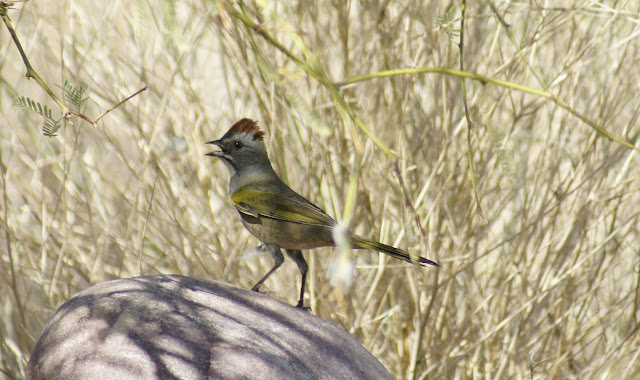The Gilbert Water Ranch is an excellent riparian area in southeast Phoenix that plays host to over 200 species of birds throughout the year. The site itself is actually a water reclamation and recycling facility, but the dozen or so hold ponds are nicely surrounded by pathways and bordered with all manner of foliage, from desert scrub to cottonwood.
Maria and I had gone to the Water Ranch last December with my family while we were still engaged and had a great time. The migratory winter birds were settled in, and we saw Vermillion Flycatchers, Green-Winged Teal, White-Crowned Sparrows, Cinnamon Teals, and much more. This was all before the discovery of the camera, however, and now I must return to this unfinished business and begin photographing the diverse fauna that passes through. It's still too early for the wintering birds to arrive, but this first trip was very fruitful nonetheless.
This weekend's birding actually started out with a preliminary trip to the Rio Salado Audobon Center, which yielded some nice pictures of a Green-Tailed Towhee, a new bird for my List.
The Yellow and Red on these birds is really impressive in the sunlight, and is all the more accentuated by their bold behavior. My first encounters at the Water Ranch were with the Abert's Towhees that so love to flit about in the shady undergrowth. Their spurts of movement always distract the optimistic birder, who hopes for a low-lying warbler or some other, more colorful wonder. I don't know the order of the ponds at the Water Ranch, but from my parking place I ended up at Pond 6 first, which was nicely identified and guarded by the friendly neighborhood mockingbird. I was then greeted by the now familiar shriek of the Rosy-Faced Lovebirds, who seem to be expanding and solidifying their population in Arizona with remarkable quickness. It may also just appear that way because they're loud, colorful, and super gregarious. I've now seen at least one Lovebird on every single birding excursion I've made this year in Arizona. I don't mind that at all. The pond itself was a couple feet of water surrounded by rather hostile and thorny desert shrubbery, but it was well attended even so, and the birds probably do not know or care about what heinous scratches I endured to enhance their vanity through pictures. Canada Geese seemed to be the bosses of the pond, but they soon were scared off by something and evacuated. Spotted Sandpipers hugged the shallows, apparently unready for the rising sun. The Least Sandpipers were already hard at work though, running about on their beloved mudflats and daintily devouring lovely little bits of filth. I moved on to adjacent ponds and saw some of the same, although some shy Snowy Egrets caught my attention as they probed the shoreline, snapping up this and that with a cool nonchalance. The next pond was basking in full sunlight, which is not always a photographer's best friend (at least, when you're on the west coast of the pond). This did not bother the Black-Necked Stilts or Avocets, nor the occasional Greater Yellowlegs that patrolled the sandbanks. It was a busy pond, and probably hosted over a dozen species at any point in the morning. In addition to the Stilts, Avocets, and Yellowlegs, there were other Sandpipers, Mallards, Blue-Winged Teals, Geese, Cormorants, Killdeer, Egrets, and Herons. Black-Necked Stilts are one of my favorite wading birds. Their elegance, daintiness, and exuding gentleness (they're not actually gentle, they just look like it) have a very calming effect not only on the appreciative photographer, but on nearby birds as well. The ponds are not much to look at, but I haven't seen such dense concentrations of birds anywhere else in Arizona. The Greater Yellowlegs probably resents people only ever noticing his legs. He has a nice long bill and especially soft feathers, but all anyone ever wants to talk about is his legs. Such is his cross to bear, for having such nice yellow legs. At this point I had wandered more or less into the center of the Ranch. As I mulled over which way to next proceed, a Great Egret flew overhead, beckoning that I follow to the southeast. While romping about, I also saw the usual medley of desert doves, along with Wilson's and MacGillivray's Warblers. I then inadvertently flushed what may have been a Virginia Rail, but I only caught a fleeting glimpse as it disappeared into the thorny thickets. Curve-Billed Thrashers and Abert's Towhees abounded and I spotted a Warbling Vireo rustling overhead. My attention was then drawn to a large, chalky-white dove perched in an adjacent mesquite tree. At first I assumed it was a plump White-Winged Dove, but the diagnostic black collar reminded me of the Eurasian Collared Dove, a new one for the List! These are the sorts of birds that are neat to see because they're easily identifiable and attractive, but they are also less publicized, so there's still a bit of discovery involved. The total absence of any scaling, speckling, or wing bars is pretty unique in the avian world. In a similar vein, I was also lucky enough to finally get some good Warbler photos, and of the very handsome Black-Throated Grey Warbler no less! It was a birding weekend all in all. I added nearly a dozen new entries to the website and 5 new entries to my Life List. I am really looking forward to revisiting the Ranch as the migratory birds arrive, and am continually amazed at these relatively close by, semi-urban birding environments that seem to offer as much in way of birding as the austere wilderness preserves way outside of town (although the landscape itself is seldom aesthetically pleasing, except at the Desert Botanical Gardens). |

















No comments:
Post a Comment